Table of Contents
Foreword by Ron Jeffries
If you’re going to do Scrum training, Karen and Sam’s book will be a gift from the skies. Using Sharon Bowman’s Training from the BACK of the Room style, they show you everything about how they put a class together. Everything? Just about the only thing they don’t provide is the flipcharts and markers you’ll need for the class. And ask them - maybe they’ll send you those as well!
For each topic in the entire course, they show you their 4Cs cards, planning how that topic will be done in BACK of the Room style. The cards alone are valuable: they show you how to plan topics in that style, and give solid examples of how these experts do it. They show you their slides, hand-drawn, dynamic, alive. They tell you what they say, what questions they ask, what’s likely to happen, how they handle it.
Frankly, it makes me want to be there.
You could do your course exactly like this one, but that’s not the point. Your course needs to be in your style. But you’ll do well to look, not just at the specific way that this or that topic is handled, but at all the various ways they’re handled. Karen and Sam show you how they do specific topic sessions, but seeing how they arrange the 4Cs for sessions is equally valuable. They mix and match Move, Speak, Draw, Listen, and Write activities for each topic and each part. They figure out how much time each part needs.
One of the hardest parts of trying a new style, like Training from the BACK of the Room, is figuring out specifically how to fit your knowledge into that pattern. Karen and Sam give us example after example, and those examples will help us create our own. You might want to dip your toe into the style, or jump all the way in at the deep end. Either way, you’ll be ready.
Sometimes there’ll be one topic in your training that’s a bit stale, to you, or to the students. Or there’s a topic where you don’t have a handle on a good way to approach it. Again, look into this book. See how Karen and Sam address this topic, but also consider applying their approach to another topic to the one that troubles you. You’ll be glad you did.
But wait, there’s more! There are masses of additional materials that you can download. Training plans, slides, a workbook, PDFs! I still think there’s probably a link for flipcharts and markers, but I just haven’t found it yet.
Get this book now, and watch for its updates. Your teaching will improve, and so will your sense of enthusiasm. Well done, ladies!
Ron Jeffries
Foreword by Sharon Bowman
Agile coaches and trainers are a notoriously enthusiastic group – passionate about what they teach, eager to help others learn, and always willing to go the extra mile to make their classes the best that they can be.
A challenge appears when Subject Matter Experts (and agile trainers are, indeed, SMEs) realise that knowing the subject is one thing but teaching it is something entirely different. In fact, teaching it requires a totally separate set of skills than simply knowing all there is to know about agile.
Enter Karen and Sam and their newest book Growing Agile: A Coach’s Guide to Training Scrum. In this detailed yet easy-to-follow guide, agile trainers will find all the lesson plans, instructions, activities, materials and resources they need in order to teach Scrum and agile concepts well.
The guide is a gem of a book – a one-of-a-kind resource that agile trainers will wonder how they ever did without! Karen and Sam have taken the best of brain-based training and combined it with the best of their Scrum classes. In doing so, they have created a guide that contains not only the lesson plans for a full two-day Scrum/agile training program, but a wealth of how-to information: easy learning activities, scripted instructional strategies, unique pictorial slides, engaging participant workbook and handouts, and lots of fun, interactive ways to present Scrum and agile concepts.
If you are an agile trainer, the guide will become your constant companion. Karen and Sam provide lots of encouragement along the way, and lots of variations to make sure your training participants get what they came to get: a rich, memorable, practical and useful brain-based learning experience. The authors have walked the walk; now they talk the walk so that others can follow.
My personal congratulations and “bravo!” to Karen, Sam, and Growing Agile: A Coach’s Guide to Training Scrum.
Sharon Bowman, Author
Training from the BACK of the Room
Praise for Growing Agile: A Coach’s Guide to Training Scrum
I have been an agile advocate for over 13 years and have been teaching Scrum for almost two years. Recently, I submitted my training material to the Scrum Alliance to become a Certified Scrum Trainer.
As I waited for my material to be reviewed, I came across Growing Agile: A Coach’s Guide to Training Scrum by Karen Greaves and Samantha Laing. From the very first read, I became a fan. So much so that I adapted my own material for a training course I was giving two days later! A big ask and I had to work hard to fit it in. But it was truly worth it.
The course feedback was unequivocal. Karen and Sam’s material helped me improve my course satisfaction significantly. Not only that, a common thread was from executives who attended the first two hours of the course only and who wished they had been able to stay for the rest, they enjoyed it that much.
I’m now in the process of updating the material I submitted to the Scrum Alliance, to use some of the great material provided by Karen and Sam. I recommend it without reservation.
Derek Davidson
Scrum Trainer, Agile Coach and ScrumMaster
Acknowledgements
A big thank you to the following people for reviewing this book:
Concetta Isolano: our Scrum wife, especially for pointing out every missing full stop.
Pavel Dabrytski: for someone whose first language is not English you know much more about grammar than we do. Thank you for all the tips. Without you this book would not be the same. It would certainly have longer sentences, less full stops and much repetition and tautology.
Justin Kotze: for testing out the material and giving us some good tips to include in the book.
This book would not have been possible without our collaborators.
Editor: Melissa Fagan
Designer: Loanne Myburgh
Thank you
About the Authors

We have worked in software our whole lives. With Type A personalities and a strong work ethic, we have both done our share of overtime on death march projects. Eventually we knew we had to find another way. Agile brought us together when we worked at a company trying to do Scrum for the first time.
In 2012, we took the plunge and started our own business, Growing Agile. Since then we have been doing the work that we are passionate about. Best of all we have an impact on other people’s lives.
If we have one principle at Growing Agile it is continuous experimentation. We love trying new things and don’t let fear of failure get in the way. Our first book Collaboration Games was one experiment and the feedback was overwhelming. Plus we had a lot of fun in the process. This led to our second book, which you are reading now. We hope you enjoy it, and use it to grow agile.
As always, we love feedback, so don’t hesitate to send us your thoughts via email info@growingagile.co.za or Twitter @GrowingAgile.
Chapter 1: Introduction
Part of the ScrumMaster role is to ensure that everyone in their organisation is educated about Scrum. Over the last few years we have come across many ScrumMasters who have great intentions of running training. Unfortunately they get bogged down in the preparation and don’t ever get round to delivering the training. That was the inspiration behind this book.
We have been training teams in Scrum for about three years now. Over the last year we have trained Certified ScrumMaster classes worldwide. During this time we spent many hours preparing training plans, workbooks, flipcharts and slides. Our materials have been continually refined through feedback. All our courses use Training from the BACK of the Room (TFTBOTR) principles.
This book is a collection of all our Scrum training materials. The aim is to help you get over the preparation hurdle and focus on training Scrum.
What’s in this book
This book contains the training agenda, training plans, slides, workbook and activities we use to deliver a two-day Certified ScrumMaster course. Each chapter covers a topic from the course.
The book will not teach you what Scrum is. It assumes you are familiar with Scrum, and have been trained yourself. It will teach you how to share that knowledge with others. This book does not assume you have experience as a trainer.
How to Use This Book
We suggest you read How To Use The Coach’s Guide Series and Agenda and Timings first. You will then understand how the book is structured, and how to structure your course. You can then browse the topic chapters in any order based on the topics you need to teach.
Once you have a feel for what the topics include, you can put together your own training course by combining sections from this book. Use the guidelines in Agenda and Timings to help you to structure your agenda.
The chapters that teach the Scrum meetings make use of a LEGO simulation that runs as a common thread throughout the materials. If you want to run a short session on just one meeting, you can change the simulation to instead use actual examples from the team’s current work.
About LEGO
A large part of this training involves a LEGO simulation. Simulations are a great way for people to experience Scrum as they learn about it. You will also be surprised by how building LEGO brings out exactly the same learnings that you have seen in teams doing Scrum with software.
You can download our LEGO book in the Coach Toolkit. This book is our Product Backlog for the LEGO simulation. Our vision is to build a LEGO zoo. Most of the backlog items have pictures to show what needs to be built. A few items (like the camel and bridge) do not have pictures, just a description of what is needed. We find having a few without pictures provides a valuable teaching point on different types of requirements.
In order to run the simulation with our backlog you need to ensure you have the correct LEGO. For training with 60 people our training kit includes the following LEGO sets, split into eight bags:
Unfortunately the Safari Set is no longer available.
UPDATE August 2016 We have created a new backlog (LEGO Farm) with LEGO that is currently available. We have added a new LEGO book to the coach toolkit with this backlog. If you chose to use the LEGO Farm you will need the following LEGO sets.
We also highly recommend some bags for the LEGO. They make it quick and easy to close up the LEGO while you are teaching, so that people don’t get distracted. If you are buying them get the 40-inch size. If you can’t get these shipped to your country, you can make your own with some fabric and drawstrings.
The hardest part of the simulation is for people to find the correct pieces. Most people don’t anticipate this, and it provides a great opportunity to teach people about impediments and assumptions. To ensure this happens, you need to have many more pieces of LEGO than are required to build your backlog. It is useful if some items on your backlog require very specific pieces of LEGO. It is even more useful if there are only a few of those specific pieces. The LEGO should also be mixed together and then split evenly amongst the tables, so that people have to find pieces on other tables. Plan for around 300 pieces per table or more.
If you are unable to find the same LEGO, you can create your own backlog by building some items with your LEGO and taking photos. If you create your own backlog, try to make sure at least one of your highest priority items is difficult to complete in the first sprint, like the zoo entrance. This creates a great teaching point around scope negotiation and splitting backlog items. Create some items with only a description and no photo, like the camel and bridge. This enables a teaching point about the backlog containing requirements versus solutions.
What else do you need?
In How To Use The Coach’s Guide Series we outline our standard training kit. For this book you need a few more items in you kit, below is our expanded list.
- one set of Planning Poker® cards
- prize for the table group that wins the quiz (we give chocolates!)
- scissors and glue for each table
- coloured pipe cleaners or similar for participants to fiddle with for each table
- LEGO for each table. See About LEGO for details
- LEGO books for each table. These are available in the Coach Toolkit. They are used throughout the training.
- Recap cards for each table. These are available in the Coach Toolkit. They are used in the Recap chapter
- Scrum Role cards for each table. These are available in the Coach Toolkit. They are used in the Scrum Roles chapter

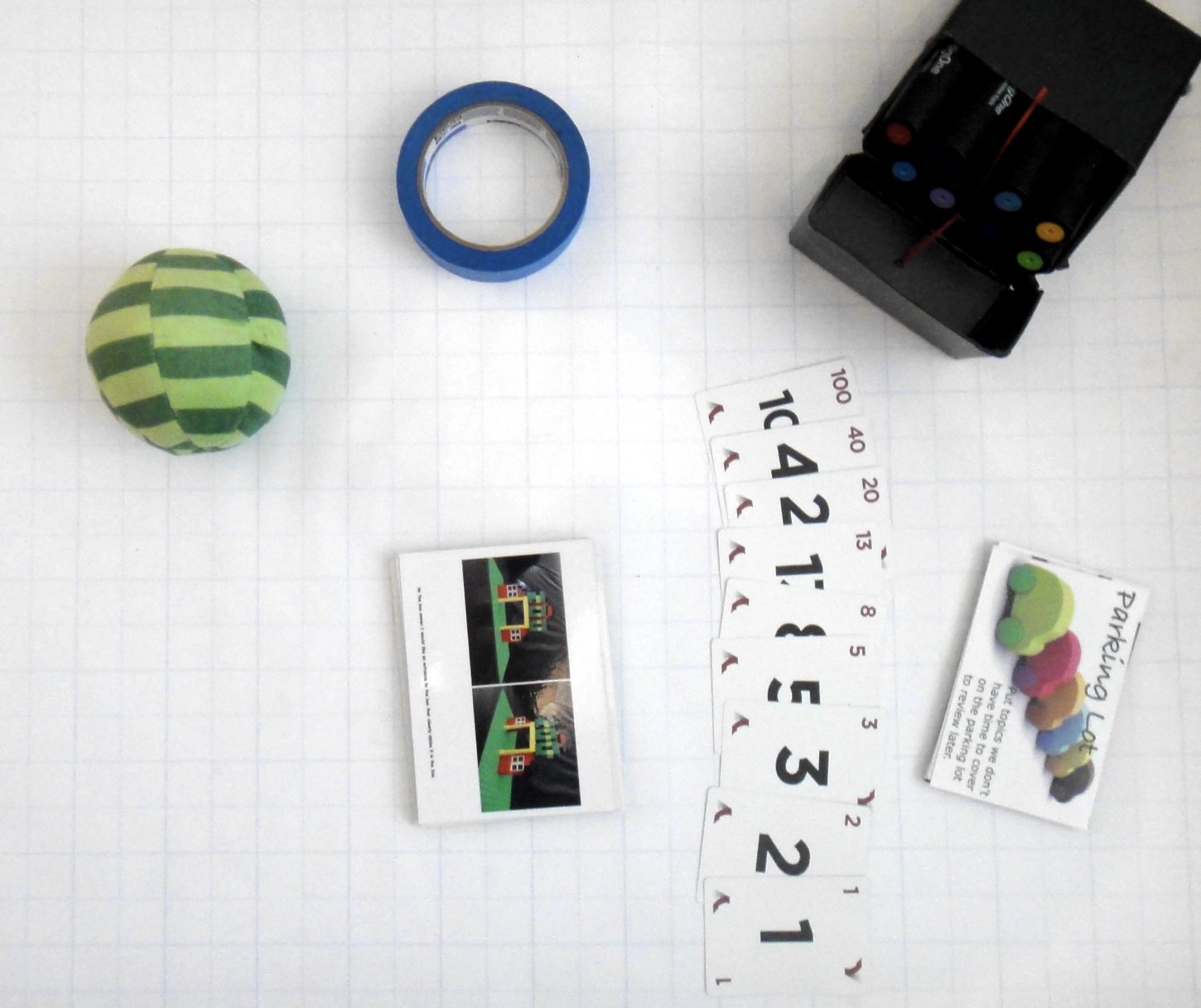
How To Use The Coach’s Guide Series
As agile coaches we often find ourselves running workshops or training sessions with people we are coaching. We put a great deal of effort into creating the plans for these sessions to help the participants get value. Over the past 2 years we have collected a lot of these plans. This series is our way of sharing these workshop and training plans with other agile coaches to enable you to run similar workshops.
All the books in this series are structured in a similar way, this section explains the concepts you’ll need to effectively use any of the books in the series. We’ve put it here at the start of the book, so that if you’ve used any of the other books in the series you don’t need to read through this again, it’s the same in each book.
4Cs Plans
Each chapter in these books includes a 4Cs plan. The technique comes from a training style called Training from the BACK of the room (TFTBOTR) developed by Sharon Bowman.
TFTBOTR is based on how adults learn and is focused on maximising learning and retention. TFTBOTR describes four parts that should be included in any training plan. These parts are known as the 4Cs and are described below.
- C1 – Connections: To get participants to connect with each other and the trainers, and to connect participants to what they might already know about the topic
- C2 – Concepts: Some facts and theoretical concepts about the topic
- C3 – Concrete Practice: An activity or simulation to experience the topic
- C4 – Conclusion: An opportunity for participants to evaluate what they have learned about the topic
Another important part of TFTBOTR is making sure you use a variety of methods to keep people engaged. Read more about it in this article on the Six Trumps by Sharon Bowman.
After using this technique extensively for training, we started using it for workshops as well. The 4Cs plan is a great way to weave new information or a technique into a working meeting. You can use C2, the concept stage to talk briefly about a technique, then spend time in C3, getting practice on using the technique on your work items.
We drive all our workshops and courses from these 4Cs plans. If you usually train from slides this might take time to get used to. We print out the 4Cs plans and refer to them during the course or workshop to see what’s up next and if we are on track.
We have created our own template for the 4Cs plans. The template can be found in the Coach Toolkit for each book. Use it to create your own training plans.
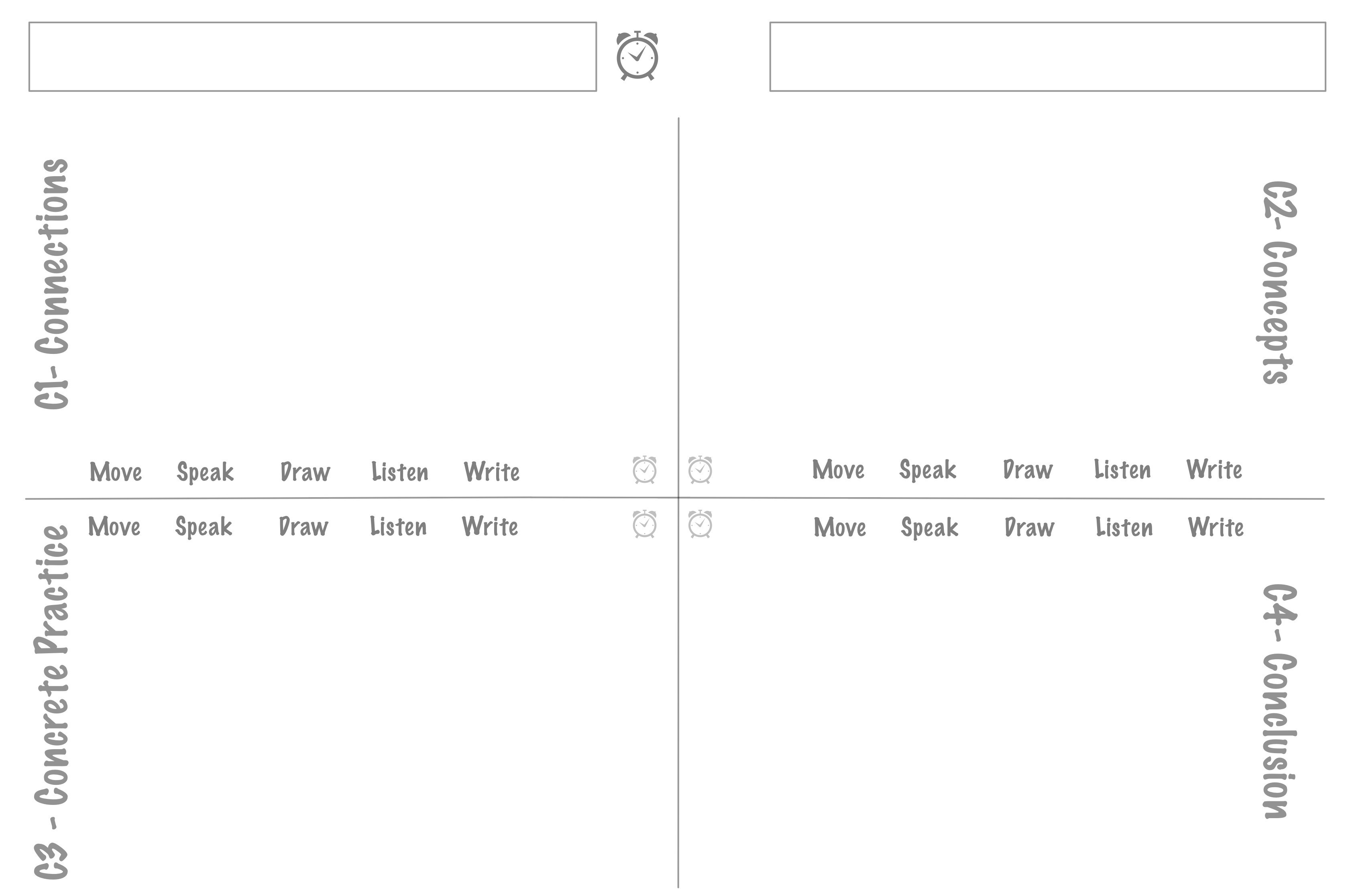
Here is a short overview to help you understand the template.
- The box in the top left corner is for the name of the topic.
- The big clock icon gives the time for the entire plan; the smaller clock icons in each quadrant gives the time needed for that section.
- The box in the top right corner has a space for you to enter the time for a section. For example 9:00 to 9:30 am. This helps you stay on track during the training. These are not filled in on the training plans we provide. We suggest you fill them in when you have planned your training.
- The rest of the page has a quadrant for each of the 4Cs. C1 covers connection activities. C2 is for concepts and is quite often a short lecture. C3 is for concrete practices or some activity to help people understand what they have learned. C4 contains conclusions of how people might apply the learning.
- At the bottom of each quadrant you can circle what the participants are doing in each section: Move, Speak, Draw, Listen, Write. This helps ensure that you have sufficient variety in each topic.
Chapter Layout
Each chapter contains the following:
- overview of the topic covered in the 4Cs plan
- 4Cs training plan
- notes on delivering each 4Cs part
- slides used for the topic
- exercises used for the topic.
Once you have a feel for what each topic covers you can structure your own workshops using one or more topics depending on your goal and time available.
Coach Toolkit
Each book in the series includes a Coach Toolkit which you can download from Leanpub. The toolkit contains the following items.
Training plans: PDF combining all the 4Cs training plans. You should print these out and use them when you train. You will notice that these plans are handwritten, we find them much easier to create and change by hand than if they are typed.
Slides: PPTX containing all the slides used. These slides were created using scanned hand drawings. Some slides have been edited to allow you to insert your own details. For these slides we used Lauren C. Brown font as it closely matches the handwriting on the other slides. If you prefer not to use slides you can recreate these images on flipcharts.
4C template: Use this blank template to create your own 4Cs plans on new topics.
Agreement Cards: PDF of cards used in the Getting Started chapter of each book. We printed and laminated them and use them in nearly every workshop we run. You don’t need to use all the cards each time. Look through the cards before each workshop and decide which agreements are appropriate. The cards help make sure you don’t forget anything important.
Workbook: DOC containing all the pages of a participant workbook. You should print one per participant for them to fill in. Feel free to edit the order and cover page of the workbook. Many of the workbook images were created in Omnigraffle and pasted as images into the workbook.
Handouts: Not all books in this series contain a workbook, since we generally only use workbooks in training courses. For topics that work well individually we provide PDFs of handouts that can be printed for each participant.
Other materials: PDFs containing materials to be printed and used in various chapters. Each chapter will reference these if they are needed. These are different in each book.
Room layout
We have trained in a variety of venues around the world, including a computer training centre, a bar and a tent! Room layout can have a significant impact on your training.
Our preferred room layout is cabaret style. i.e. small round tables seating groups of five to seven comfortably. The room should be large enough to have open space for some of the discussions. We look for a room with dimensions 7m x 9m for 20 people, with four tables. Ideally the tables should be small enough (around 1.5m–2m diameter) that people can easily talk to everyone at the table, but still have place for everyone to take notes.
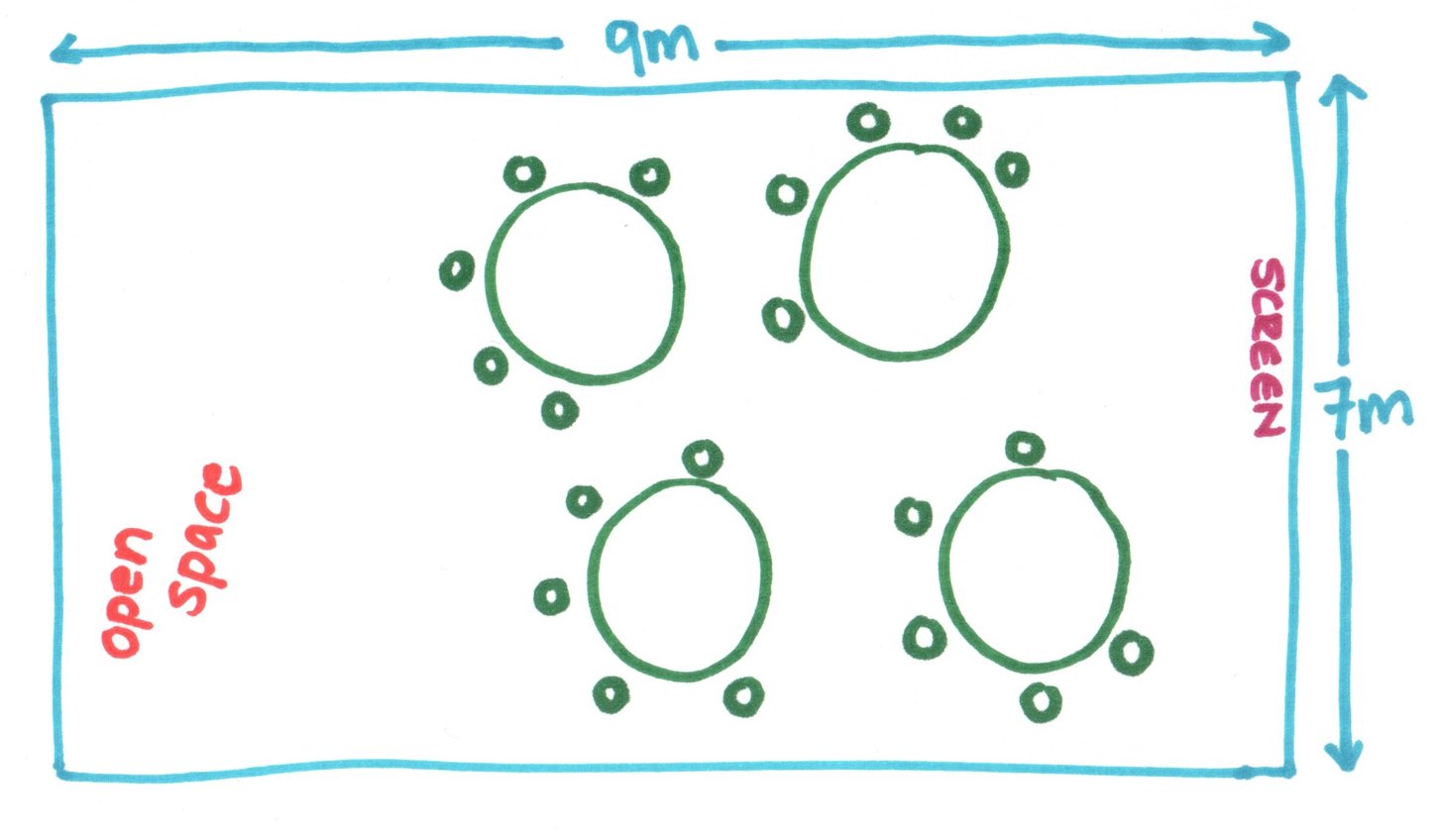
Don’t worry about allocating seats when people arrive. The Getting Started chapter includes an activity for the participants to self-organise into appropriate groups.
If you are facilitating an in house workshop with only six participants, try find a room with a small round table so that everyone can sit close to each other.
When to change exercises
Feel free to change the training plans and activities to suit the class size and time available. We have delivered most of the chapters to groups varying from five to 50 people. As a result we have developed activities that scale well, but it is a good idea to be aware of the size of the group when planning your activities.
All 4Cs plans give times for each activity. These are just guidelines; any activity can be adjusted based on time available. It is often useful to have two exercises on hand, a longer and a shorter one, so that you can adjust if you find yourself with more or less time available.
If you are working with large groups, be aware that debriefing exercises can take much longer. To save time you can have teams debrief in their table group and then ask one or two table groups for their insights. Also remember that some exercises speak for themselves and don’t have to be debriefed - this is the beauty of TFTBOTR.
What else do you need?
We are able to run most of the workshops in this series with our standard training kit. We keep this packed in a small suitcase on wheels so we can take it wherever we go. Below is a list of what you’ll find in our kit. Some books in this series require specific items, these are listed in the Introduction for each book. Each chapter also contains a full list of materials you need for that topic’s training plan, in case you plan to deliver just one topic.
All the techniques referenced in the training plans are available in the Appendix. If you aren’t sure what to do for a Standing Survey or Fast Pass, check the Appendix.
After the workshop or course
Whenever we train or run workshops we take photos. These include action shots during any activities and discussions as well as any flipcharts we use and posters people create.
After the workshop or course we put these photos together in a PDF, and send this to all participants as a reminder of the workshop or course. This photobook is useful if you don’t use slides and participants want some materials to reference afterwards. We also send links to further reading on any topics that came up in the Q&A that were not fully answered.
Chapter 7: Values and Principles
For this topic the aim is to have everyone understand the values and principles behind Scrum. We firmly believe that any question can be answered by looking to these values. Often during a class, instead of answering a question we ask the class “What values are being affected here?”. Most times the answer is then self-discovered.
4Cs Training plan
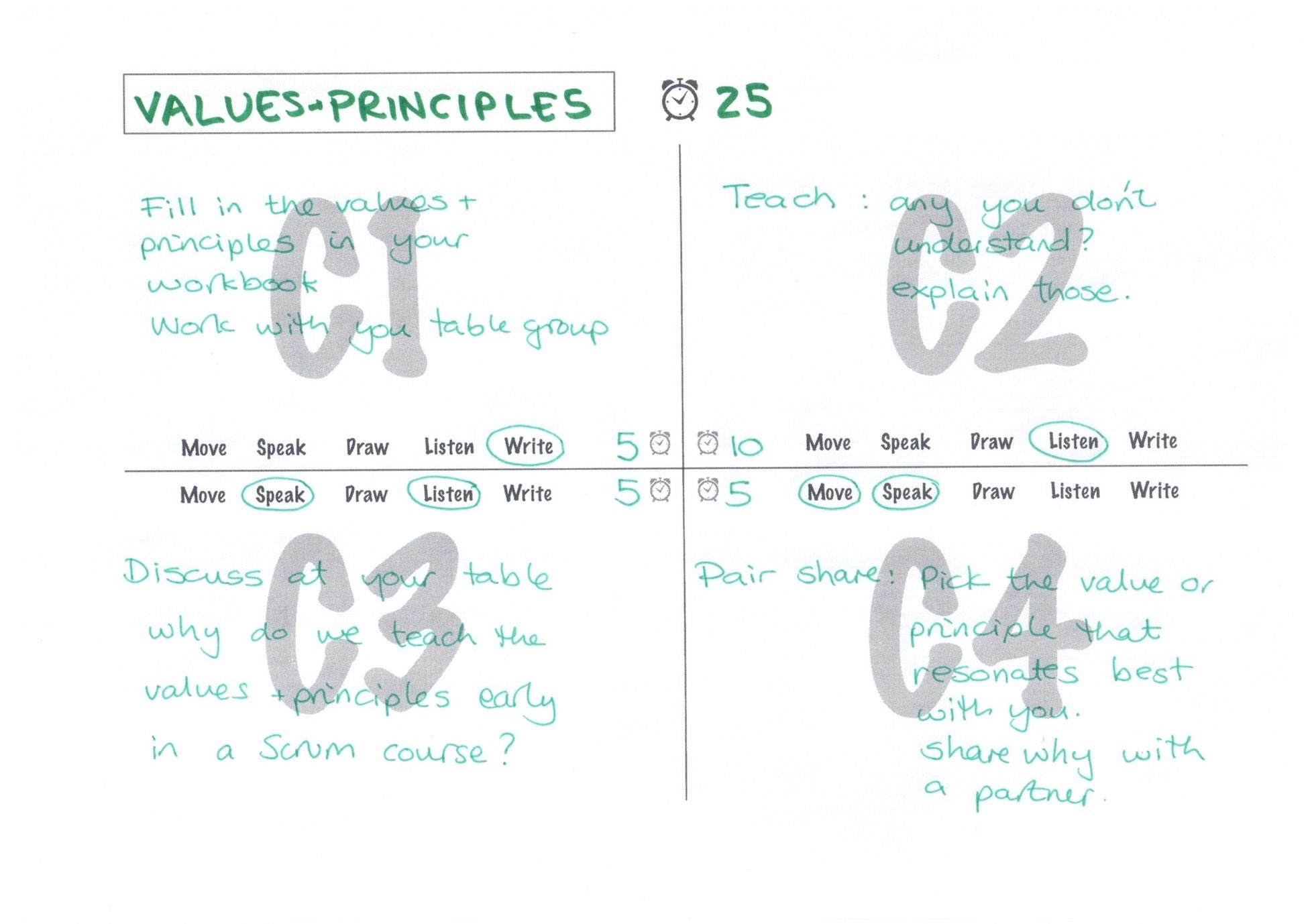
Fill in (C1)
Ask everyone to open their workbooks to the Values and Principles exercise, and fill in what they can. Encourage them to use the people in their table groups to help complete the words.
You could walk around the room and throw in a few extra letters to allow people to guess the words. You may even wish to drop to one knee to help with the word, “commitment”!
Workbook
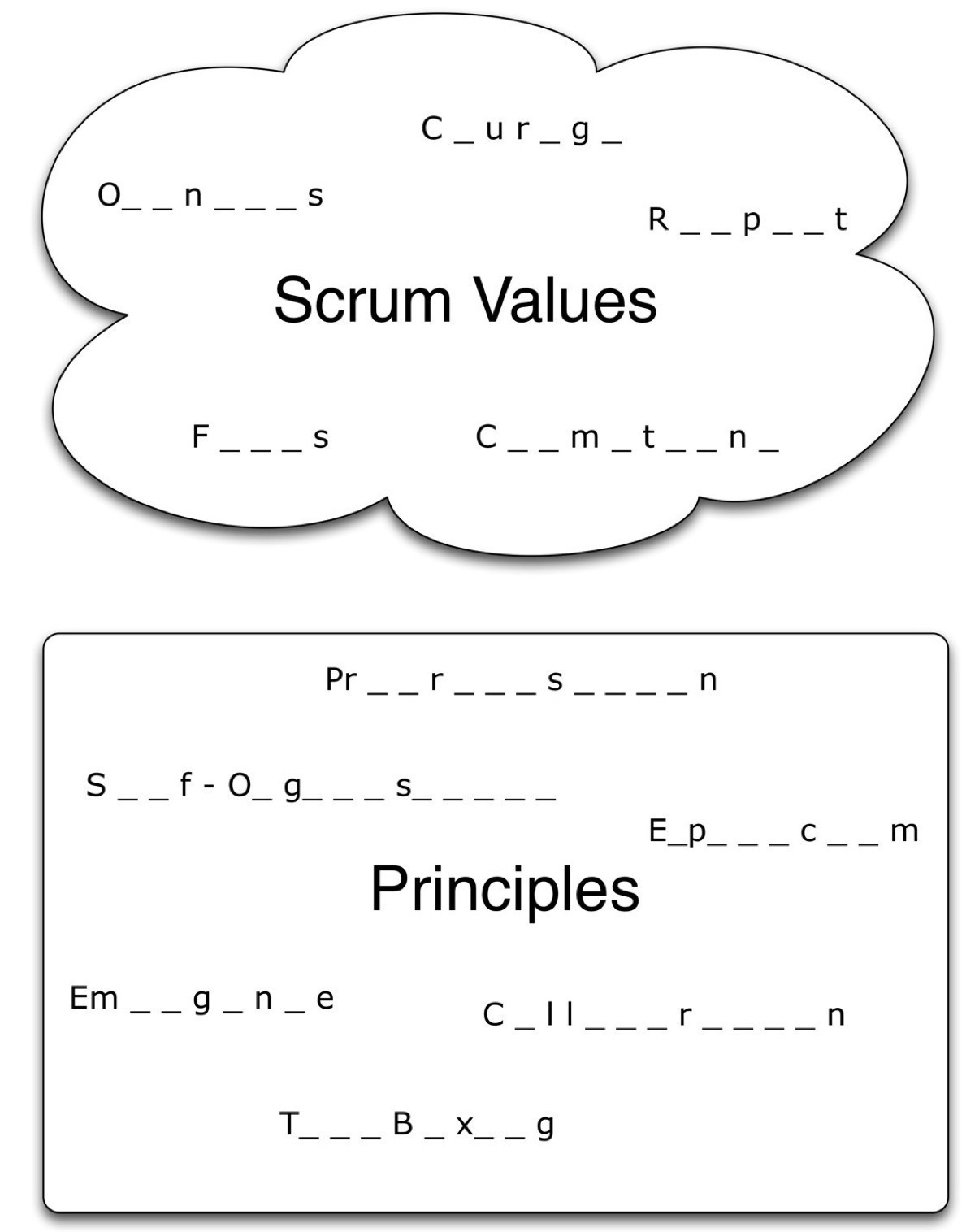
Teach (C2)
Show the Scrum values slide and ask everyone to check their answers. Then ask if there are any that need explaining. Write those on a flipchart. Next show the Principles slide, and again make a note on the flipchart of any that are not understood.
At this point explain that the values are codified. They are the Scrum values. However each trainer and coach has their own set of favourite principles and these are ours. Then explain the terms on the flipchart for about one minute each. We usually need to explain empiricism, emergence and timeboxing - but each class is different.
Slides
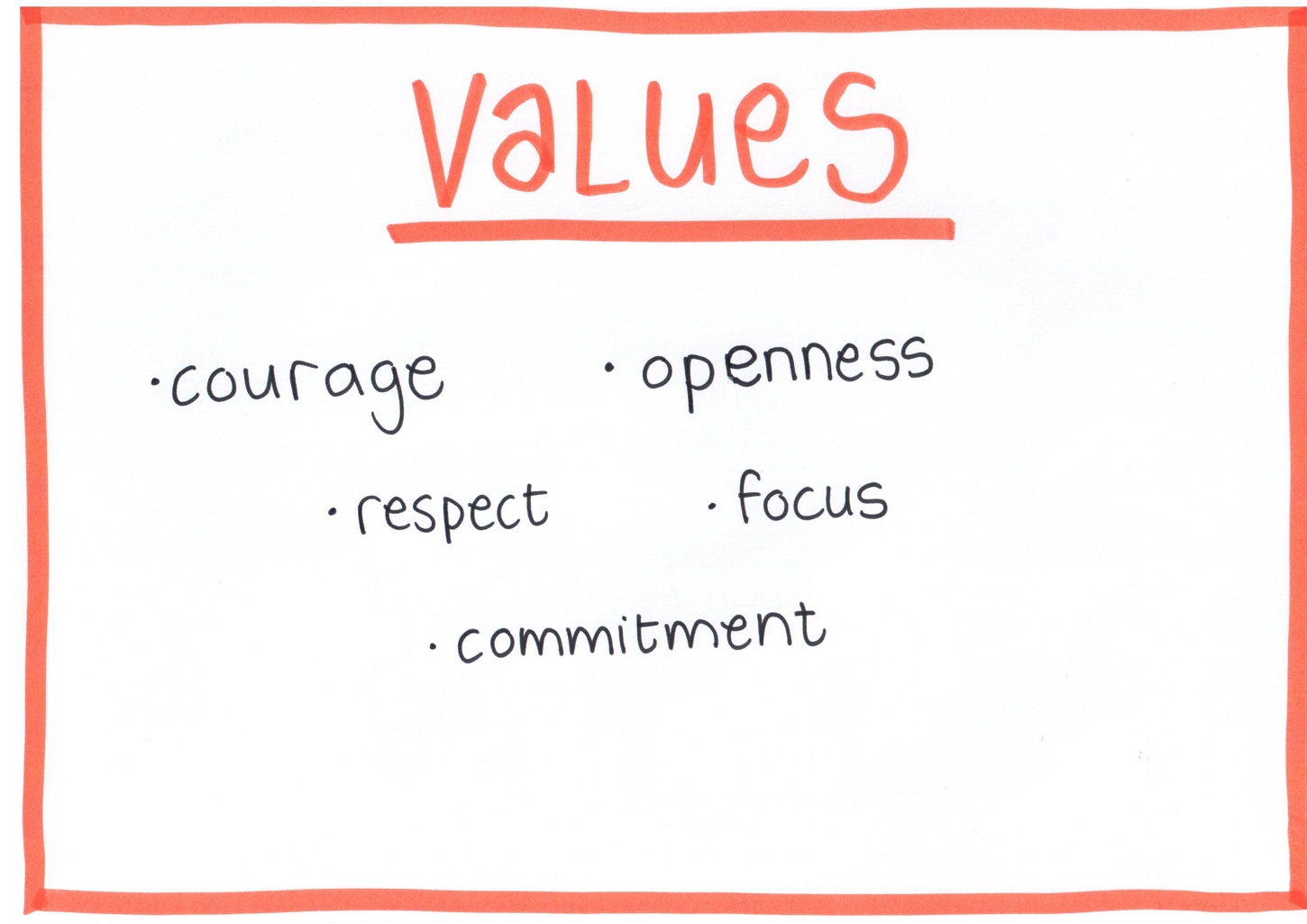
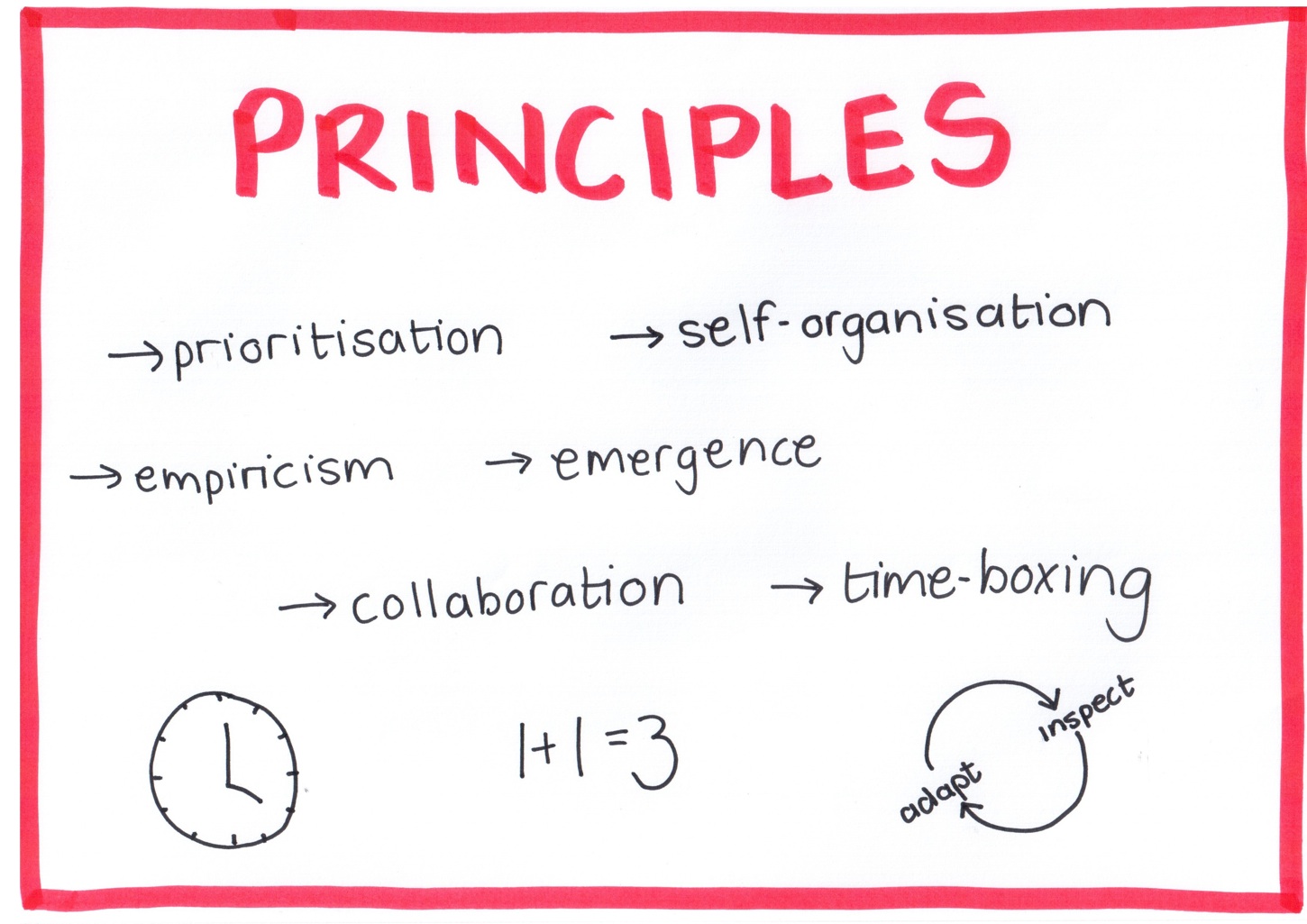
Pair Share (C4)
Ask each person to pick one value or principle that resonates best with them, and then share that with one other person in the room. This reinforces the values and principles and gets each person to connect emotionally with another person in the room.
Appendix
Standing Survey
| 5 - 10 | any number | Visualisation | ||
| minutes | people | Movement |
What you can learn
This is a great technique to introduce movement into a session as well as visualising information.
What you need
Decide what questions you will ask, and how you will ask people to arrange themselves in the room.
Having some open space in a room without tables and chairs is useful.
How to do this
Ask people to stand. Explain that you want them to organise themselves in the room according to some criteria (e.g. amount of Scrum experience).
Explain how to organise themselves (e.g. a single line, with no experience near the door, and most experience near the other side of the room).
Allow time for people to move around the room.
Remind people to speak to others to see where they should stand relative to each other.
Ask people to notice where other people are relative to them.
How we’ve used this
Some ideas for criteria to organise by:
- how easy you think something will be to implement (easy: one side of the room, impossible: the other )
- how well you know people in the room (close to those you know, far from those you don’t)
- people’s roles within an organisation (a quadrant with a different role in each corner of the room)
- where people are from (in the centre: close by, edges of the room: far away).
Who shared this with us
Pop-Ups
| 1 | any number | Movement | ||
| minute | people |
What you can learn
An easy way to introduce movement into any session.
What you need
Nothing.
How to do this
In any section where you want to introduce movement, and you need to get individuals to speak, introduce Pop-Ups. Explain that a Pop-Up means that you need to stand up before you speak. Ask people whatever question requires input from them. Remind them to stand before they speak. Often this results in a Shout Out without standing. To counter this we act dumb and ask “Sorry, what was that?”, “I can’t seem to hear you?” until the person realises and stands up. Also good for a few laughs in the class.
How we’ve used this
You can ask questions where people have to stand if they think the answer is yes. Use Pop-Ups to brainstorm ideas. Ask a question like, “What are some aspects of a great team?”
Who shared this with us
Growing Agile Online Courses
We offer several online courses aimed at Scrum Masters, Product Owners and Agile Teams.
If you are ready to get a taste of what our online courses are about sign up for our FREE five week Scrum Master or Product Owner email course.
Our online courses are a little different to regular online video courses. We’ve applied the principles of Training From The Back of The Room to our online materials. That means each course comes with a workbook and exercises for you to do, as well as video’s to watch and techniques that you can use with your teams. Each activity is intended to deepen your knowledge of an area, so we suggest doing the course over a few weeks and taking the time to do all the exercises.
Take a look at our offerings here http://www.growingagile.co.za/online-courses/.
Growing Agile Books
Scrum Master Workbook - 15 Weeks of Accelerated Learning
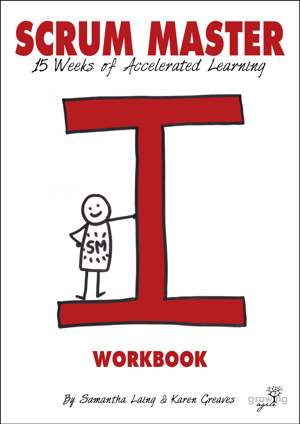
Essential for new Scrum Masters! This is a workbook you print out and fill in each week. It will guide you through a range of topics that are critical for Scrum Masters to understand. Each week will include reading, exercises and a journal page for you to reflect. We also include cutouts for your toolbox on a range of different topics.
Scrum Master Workbook is available on Leanpub.
The Growing Agile Coach’s Guide Series
This series provides a collection of training and workshop plans for a variety of agile topics. The series is aimed at agile coaches, trainers and ScrumMasters who often find themselves needing to help teams understand agile concepts. Each book in the series provides the plans, slides, workbooks and activity instructions to run a number of workshops on each topic. The interactive workshops are all created using techniques from Training from the Back of the Room, to ensure participants are engaged and remember their learnings after the workshop.
The series is available in a bundle on Leanpub, or you can purchase the books individually.

Growing Agile: A Coach’s Guide to Training Scrum
We have been training teams in Scrum for about three years. During this time we have spent many hours preparing training plans and creating workbooks, flipcharts and slides. This book will help you plan and deliver interactive, fun Scrum training for anything from a short workshop on a particular topic to a full two-day course.
Growing Agile: A Coach’s Guide to Training Scrum is available on Leanpub.
A Coach’s Guide to Agile Requirements
Our requirement workshops are aimed at different stakeholders ranging from business, to Product Owners and teams. This book is a collection of some of those workshop and can be used to help improve the way you think about and communicate agile requirements.
Growing Agile: A Coach’s Guide to Agile Requirements is available on Leanpub.
Growing Agile: A Coach’s Guide to Mastering Backlogs
Often Product Owners can’t see the forest for the trees and there are so many items in their backlog and not enough hours in the day to groom it. We run short workshops where we work with the Product Owner’s actual backlog. The workshop is a working session, and an hour later the Product Owners emerge with an improved backlog.
Growing Agile: A Coach’s Guide to Mastering Backlogs is available on Leanpub.
Growing Agile: A Coach’s Guide to Release Planning
We often hear people say “We’re agile, we don’t need a plan”! or even worse “We can’t plan”. This is just not true. We run Release Planning workshops with many organisations. This book is a collection of our workshops that will help you run similar workshops to create agile release plans. We include teaching points on a range of techniques like Story Mapping and release burnups to help you explain to other’s how to use these methods effectively.
Growing Agile: A Coach’s Guide to Release Planning is available on Leanpub.
A Coach’s Guide to Agile Testing
If a team believes they are agile, but nothing has changed about the way they test, then there is still much to learn. We teach 5 key principles that explain why agile testing is fundamentally different to traditional testing.This books includes a collection of workshops to help teams grasp these principles and adopt an agile testing mindset. It’s not just for testers. A key part of agile testing is that the whole team is involved, so we always run these workshops with everyone in the team.
Growing Agile: A Coach’s Guide to Agile Testing is available on Leanpub.
Growing Agile: A Coach’s Guide to Facilitation
It’s taken us several years to master the skill of facilitation, and it continues to amaze us how few people learn the skill, or even understand what it means. People spend much of their lives in meetings, and yet so many meetings lack facilitation. We hope the collection of tips and techniques in this book will inspire you to grow your own facilitation skills and improve the meetings in your organisation.
Growing Agile: A Coach’s Guide to Facilitation is available on Leanpub.
Other books by Growing Agile
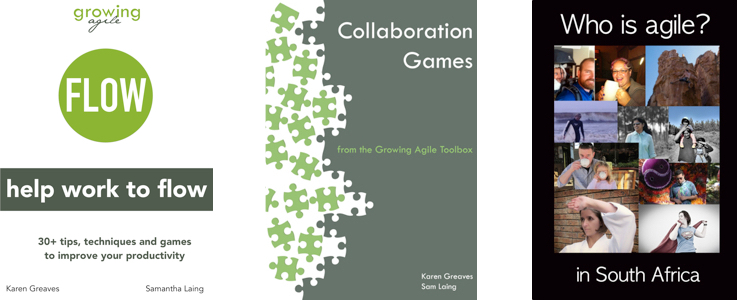
Flow
Do you have a never-ending to do list and not enough hours in the day? Imagine getting everything on your to do list done without stress or worrying. Imagine being twice as productive in half the time.
We have over 30 proven tips and techniques to help you achieve a state of flow, where time stands still and productivity soars. With these tips you will deliver value to your customers sooner in practical and simple ways. You will also be happier and less stressed.
Flow is available on Leanpub.
Collaboration Games
Add an element of fun to your meetings or workshops using these 12 short games that teach principles of collaboration.
Collaboration Games is available on Leanpub.
Who is Agile in South Africa
This book is based on the original Who Is Agile book, only this is a regional version for South Africa. It’s a collection of interviews with passionate South African agilists.
Who is Agile in South Africa is available on Leanpub.
About Growing Agile

At Growing Agile we help companies create great teams that create exceptional products. We are agile coaches passionate about helping you get the results you are looking for.
We are based in Cape Town South Africa, but work with clients from all over the world. We provide phone based individual or group coaching sessions, as well as online courses for Scrum Masters, Product Owners and Teams.
Find out more about us at www.growingagile.co.za.
Our personal goal is to help influence a million people on their path to becoming agile coaches. Our books and videos are ways we can spread that influence further than what we can in person.
We are exploring new ways to do this.
- One of our latest projects is AgilePath.me. A community resource of links, courses, books, and ideas to help you find your own learning path as an agile coach.
- We also have RemoteAgileCoach.com to help all those people who have remote team members and would like some tips and assistance.
If you’d like to stay in touch and hear about our new ventures, please sign up to our monthly newsletter.
